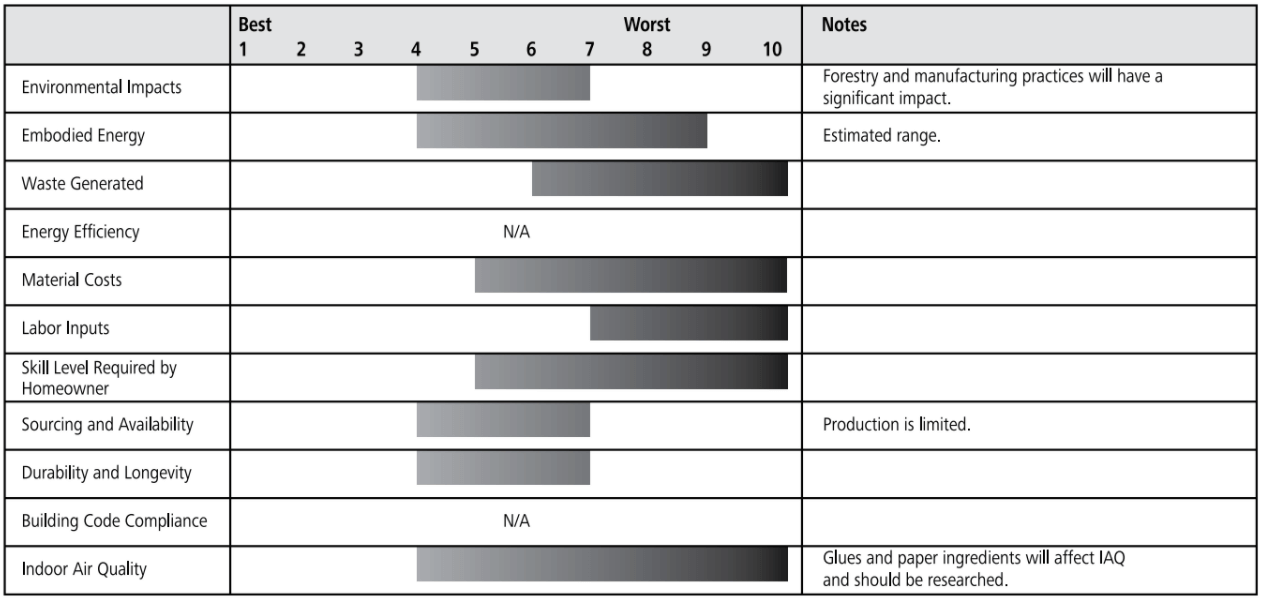Natural Wallpaper & Coverings
Finishes: MATERIALS ENCYcLOPEDIA
Applications for this system
Interior wall covering
Interior ceilings
Not suitable for use on:
– Exterior walls
Basic materials
Coated and/or embossed paper
Woven grasses or fibers
Stitching, if required (nylon, cotton, polyester)
Adhesive to attach to wall
Ratings Chart for natural wallpaper and coverings

The ratings chart shows comparative performance in each criteria category. Click on the tabs below for detailed analysis of each criteria.
- HOW THE SYSTEM WORKS
- ENVIRONMENTAL IMPACTS
- WASTE
- MATERIAL COSTS
- LABOUR INPUT
- SKILL LEVEL REQUIRED
- SOURCING & AVAILABILITY
- DURABILITY
- INDOOR AIR QUALITY
- RESOURCES
- FUTURE DEVELOPMENT
Natural wallpaper and coverings System
Decorative papers are printed and/or embossed. Grass or fiber wall coverings are woven and/or stitched. Both are made in rolls and applied to the substrate using an adhesive. Rolls are made in regular widths and are applied side by side to cover a desired area.
Many conventional wallpapers and coverings are made or surface-treated with polyvinylchloride (PVC), acrylic, polyurethane and toxic inks, and are adhered to walls with adhesives that are high in VOCs, fungicides, fire-retardants and other toxic ingredients.
In order to be considered a sustainable finish, the products must not contain any dangerous substances. There are many manufacturers whose wall coverings meet sustainable criteria, but many more that do not. Homeowners must research thoroughly to ensure that products meet all expectations.
Environmental Impact Rating
Harvesting — Low to Moderate
All-natural wall coverings are made with renewable materials. Harvesting techniques can range from environmentally benign to highly impactful. Chose products with third-party certification to help ensure minimal impacts. Recycled paper products reduce the burden on forests. The forestry industry can have impacts that include habitat destruction, soil erosion and water pollution. The harvesting of jute, hemp, bamboo and other fiber materials is centered in developing countries where it can be difficult to discern harvesting techniques or working conditions. Some third-party certification programs exist for these materials, but homeowners may need to research individual company claims.
Manufacturing — Low to Moderate
Sustainable wall coverings are typically manufactured in a highly mechanized manner but without high heat or chemical input. Homeowners must research to ensure that this is the case, and that no petrochemical additives are added to coverings or adhesives.
Transportation — Low to High
Check manufacturer proximity to job site and distribution network to ascertain impacts.
Installation — Negligible
Waste: high
Biodegradable/Compostable — Wallpaper and woven wall coverings. Ensure that inks and dyes are suitable for biodegradation.
Recyclable — Wallpaper. Containers for adhesive.
Landfill — Stitched wall coverings with synthetic stitching material.
Material costs: moderate to high
A wide range of products are manufactured at different price points. Natural wallpapers tend toward the higher end of the cost scale.
Labour Input: High
Applying wall coverings is a labor-intensive finish. Rolled material must be measured, cut and test-fitted before applying adhesive and hanging material.
Health Warnings
Check for warnings on adhesive containers.
Skill level required for homeowners
Preparation of substrate — Easy
Some adhesives require a two-part process, with adhesive applied to the wall and to the roll of wall covering.
Application of finish — Moderate to Difficult
Wall covering requires accurate measuring and cutting, and often involves lining up patterns on adjacent sheets to minimize the appearance of seams. The adhesive has a limited working time, requiring sheets to be hung relatively quickly and accurately. Coverings need to be applied in a way that avoids bubbling or crinkling. Particular care must be taken if the wall covering wraps around an inside or outside corner.
Sourcing & availability: moderate
While conventional wall coverings are widely available at building supply outlets and paint/wallpaper stores, those made with sustainable materials and using nontoxic adhesives may require sourcing directly from the manufacturer or specialty sustainable building stores.
Durability: moderate
The durability of wall coverings is largely dependent on the quality of the adhesive and the bond it forms with the substrate and the covering. Installation quality will also impact durability. The coverings themselves range in durability, but will typically last fifteen to fifty years. High levels of moisture can shorten the lifespan by encouraging deterioration of natural fibers (and possibly encouraging mold growth) and weakening adhesives.
Indoor air quality: low to moderate
A natural wall covering with a nontoxic adhesive should have no negative effect on IAQ. Many wall coverings are treated with fire retardants that are highly toxic, and should be avoided completely. Biocides and fungicides are sometimes added to wall coverings and adhesives to prevent mold growth, and these too should be avoided.
Resources for further research
n/a
Future development
Natural wall coverings are beginning to gain market share. The unique textures, colors and patterns available with these materials are difficult to achieve with other finishes. The development of nontoxic adhesives and the move toward recycled paper content and third-party certification programs for wood and fiber products will make it easier for homeowners to make sustainable choices.
Tips for a successful natural wallpaper and covering finish
1. Wall coverings and adhesives are proprietary products. Follow the manufacturer’s instructions for successful installation.
2. Wall coverings can be difficult to remove and the process may damage the substrate so it needs repair or replacement.



